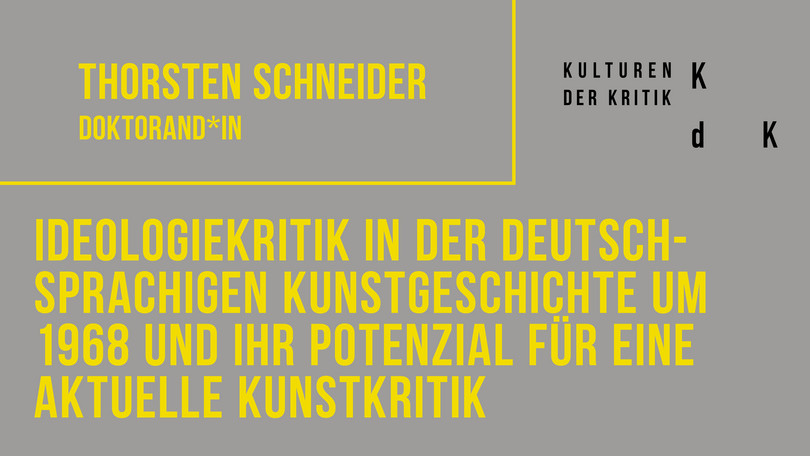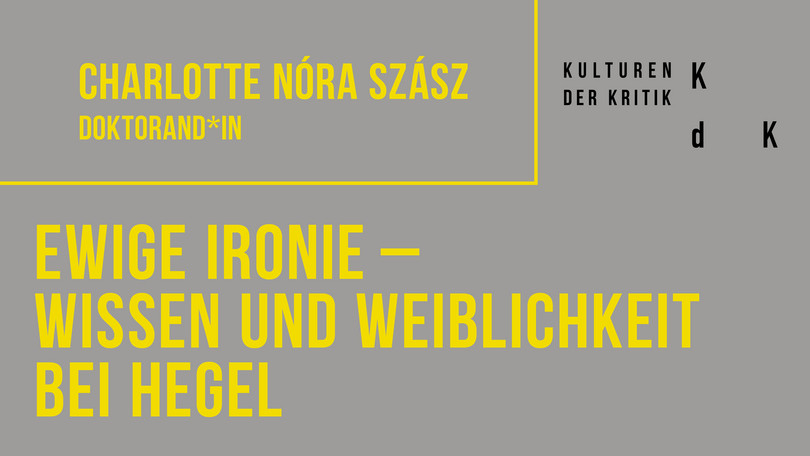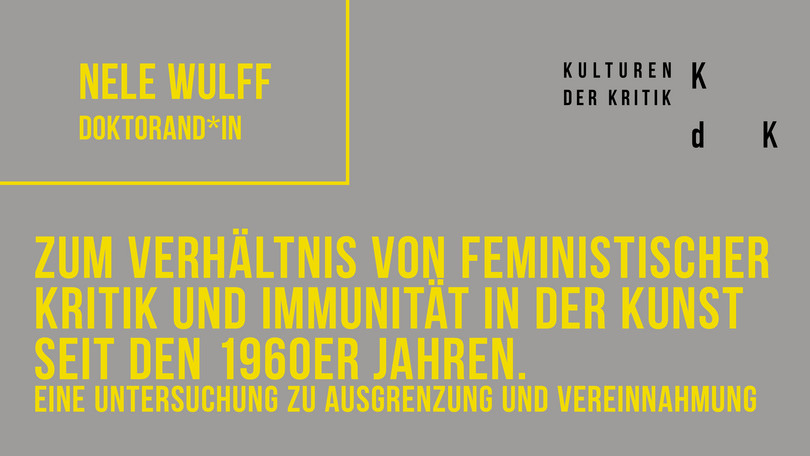The dissertation project examines the role digital cultures and technologies play in current processes of (de)carbonization. It investigates cryptocarbon platforms as media assemblages of digital (de)carbonization that (re)mediate carbon as a central medium of climate change. To do so, it traces the political media ecologies of recent initiatives that deploy AI and blockchain technologies in the field of carbon sequestration and storage. It tentatively refers to these projects as cryptocarbon, following a term proposed by the geographer Peter Howson. [1]
My research aims at providing a media cultural analysis of cryptocarbon on three levels: First, it analyzes cryptocarbon platforms as part of a larger set of media assemblages that not only incentivize carbon removal practices but rather redefine the socio-cultural dimension of carbon as a key mediating metric of climate change and its mitigation. Secondly, it investigates possible techno-political implications of cryptocarbon as a potential novel regime of remote algorithmic carbon governance. Finally, in situating the dissertation’s research within the geophysical climate realities of accumulating atmospheric C02, it aims at questioning the potential of appropriating these technologies for critical practices of decarbonization and techno-ecologies of reparation.
In doing so, this dissertation project not only aims to provide a much needed but nuanced critique of cryptocarbon and digital (de)carbonization as a speculative proposition. Furthermore, the project takes such a critical analysis as its starting point to question the possibilities, forms, and limits of critical practices under current technological, economic, and ecological conditions and their concomitant implications on human and more-than-human life worlds in a warming world of rising atmospheric CO2 levels. It proposes to rethink decarbonization beyond techno-utopian solutionism or environmental romanticism as a critical practice of envisioning and constituting a plurality of possible post-carbon futures.
[1] Howson, Peter, Sarah Oakes, Zachary Baynham-Herd, and Jon Swords. “Cryptocarbon: The Promises and Pitfalls of Forest Protection on a Blockchain.” Geoforum, no. 100 (2019): 1–9.
Seit einigen Jahren beschäftigen sich Theoretiker*innen der Dekolonialität in ihrer Analyse und Kritik der Modernität auch mit Kunst und Ästhetik/Aisthesis. Ihre Texte wurden zu Bezugspunkten für das Reden und Schreiben über Kunst sowie für künstlerische Praktiken. In Guatemala verwenden insbesondere Maya-Künstler*innen verstärkt seit 2012 entweder selbst Begriffe wie die „koloniale Wunde“ (Mignolo 2005), oder sie werden mit diesen, ob gewollt oder nicht, in Verbindung gebracht. Theorien der Dekolonialität bedeuten für diese Künstler*innen einerseits einen Zugang zur übernationalen Gegenwartskunstsphäre. Andererseits gehen sie dabei auf unterschiedlicher Weise der zentralen Forderung nach Entkoppelung (delinking) von der Modernität/Kolonialität nach. Ist Gegenwartskunst ohne Modernität allerdings nicht zu denken, entsteht ein Spannungsverhältnis, das auszuloten ein Ziel des Dissertationsvorhabens ist.
Das Dissertationsprojekt untersucht partikulare Formen, Strategien und Medien in künstlerischen und sensorischen Praktiken sowie in Praktiken des Wissens, des Redens und Schreibens über Kunst vor und nach der „dekolonialen Wende“ in Guatemala der Postkriegszeit, das heißt seit 1996. Vor dem Hintergrund (selbst-)kritischer, postkolonialer Kunstgeschichten und Theorien der Indigenität, durch die Analyse von Praktiken und Theorien der Dekolonialität und anhand eines Wissenskorpus’ über Maya-Identität, (Post-)Kriegsgeschichte und guatemaltekische Gegenwartskunst geht es mir mit dem Dissertationsvorhaben um eine Kunstgeschichte der Entkoppelung.
Dekoloniale Entkoppelung ist dabei eine radikale Strategie der Kritik, die eine Standortverschiebung des kritisierenden Subjektes und damit eine neue Subjektivitätsform der Kritik voraussetzt. Sie zielt auf eine Wieder-Verkopplung (re-linking) mit Weltanschauungen, Prinzipien und Praktiken abseits des modern/kolonialen Paradigmas. Die damit einhergehende Distanzierung von Critical Studies und vom Kritikbegriff überhaupt muss zunächst ernst genommen werden, um die (Kunst-)Praktiken in Guatemala als anders geartete kritische Praxis verstehen und in ihrem Spannungsverhältnis zu einem modernen, ehemals westlichen Kritikbegriff untersucht werden zu können.
Mignolo 2005: Walter D. Mignolo, The Idea of Latin America, Oxford 2005.
My project explores how temporal and structural norms like causality, sequence, forward-moving agency, and operative logics like deterrence and preemption, generate governance through acts of silencing the past, erasing the present and speculating about the future. Following a method of archaeology, and a transhistorical perspective, I analyse how and with what ramifications, time entered science in the Victorian era, taking into consideration the shift in focus in the late 18th and 19th centuries from quantity and timeless laws to change, growth, evolution, a change that occurred almost simultaneously in physics (thermodynamics), biology (evolution), and astronomy (evolution of the solar system). In this context that was decisive for modernity, I aim to look at the relationship between evolution and linear, asymmetrical time through the work of Victorian social evolutionists, and showcase how their main belief that all societies proceed teleologically from savagery to barbarism to civilisation in a universally same process of unfolding, reconfigured race in the 19th century. My purpose here is to eventually suggest an epistemological shift in our understanding of race, whereby race is a product of processes of spatialization [through the connection of place (continent) of ‘origin’, bodies, and forms of consciousness] and temporalization (the positioning of this triptych in unilinear, universal time). Understanding, therefore, the ramifications of the radical naturalization of Time (e.g. dehistoricization of time) that was central to the most scientific achievements of the 19th century, is crucial in order to look at the “civilising mission” and, later, “development” projects as material entanglements of political and scientific practices that operate through the promise and the deferral, of coevalness that was initially denied. In this context and taking into consideration how the West has institutionalised and disseminated its own images of progress and future, I analyse the politics of synchronization in the “development”/upward progression era, looking at the Point Four Program, modernization theory and practice, and the politics of adaptation in the survival/downward progression era looking at projects such as the Adaptation and Resilience Action Plan by World Bank, and various strategies that call for the mainstreaming of disaster risk management into poverty reduction and development.
My doctoral project aims to provide a comprehensive study of the concept of form implied in Marx’s late critique of the economy. Its deduction of the concept in a detailed reading of his later work is guided by the thesis that he conceives of form as social practice. Methodologically, the study is inspired by Althusser’s notion of “symptomal reading,” that is, it seeks to unearth the concept of form, which in Marx’s original text is implicitly necessary but not explicitly defined.
Philosophically, this project inscribes itself within the ongoing debate about a new concept of materialism; politically, it aims to give a fundamental critique of the transformation processes of capitalism today. Unlike current, “new” materialism, Marx is not concerned with a return to matter within the dualism of matter and form. He is concerned with overcoming this dualism itself. He seeks to show that this very dualism is the result of a material social process within which the concrete products of human labor are presented to the producers themselves as abstract forms. An investigation of the concept of form thus allows for a critique of the “ideologies of materiality,” that is to say, a critique of the social processes that distinguish between material and immaterial, empirical and transcendental. In political terms, then, this project takes up the discussions about the transformation of capitalism in the so-called post-industrial age. In demonstrating the materiality of prima facie immaterial products such as services, data, and the like, my study will thus allow for a qualified critique of contemporary relations of production.
Collecting, archiving, and remembering have been prominent topics in contemporary art since the 1990s. Okwui Enwezor's exhibition Archive Fever – Uses of the Document in Contemporary Art (2008), which referred to Jacques Derrida's eponymously titled text on the archive, can be considered as part of the so-called archival turn, along with the terms "memory boom" (Erll 2017) and "archival impulse" (Forster 2004). In my dissertation project, I will use methods of global art history to take a close look at this turn, which until now has mostly been applied to Europe and North America. In doing so, I will start from the assumption that the spatial references of the artistic works are connected to certain aspects of the "archival impulse" that authors such as Hal Foster did not take into account.
My dissertation focusses on archival critique in art that addresses the production of cultural identity in the context of crises and (post)war situations in Lebanon and Palestine/Israel, thereby narrating transnational histories of the region. The critical potential of artistic engagement with the archive will be examined through an analysis and regionally specific contextualisation of selected works by Jumana Manna, Akram Zaatari and Farah Saleh. I would like to demonstrate how the archival works produce various alternative narratives, against the background of a failure of local memory politics, national identity constructions, and universalistic history writing: through their method, content and form, the works can be analysed through the lens of oral history, connected histories (Subrahmanyam 1997), positioned knowledge (Hall 1994), and situated knowledge (Haraway 1988).
Working title: Memory Work as Resistance? Transnational Archival Critique in Jumana Manna's, Farah Saleh's and Akram Zaatari's Artistic Practices
In the 1960s and ‘70s, a number of artists (once again) identified the social institution of the factory as a place of artistic activity. Their approaches to the factory setting could not be more diverse: from interventions conceived as militant investigations to artists who evinced a purely technical interest in the possibilities of industrial production to attempts to bring artistic practice into direct contact with other areas of society by working outside the normal frameworks of artistic display.
The shift in the site of artistic work from the studio to the factory is symptomatic of a category of art practices that had become increasingly prominent in this period, whose focus was primarily on performative, processual and context-based methods. However, in this context it was not only discussions about conceptual practices that were important; the shift often resulted from an increased attention to the relationship between art and society, and a critical interrogation of the functions that art performed in relation to its wider social context. In my dissertation I review these factory interventions, critically evaluating the diverse artistic and political approaches artists (and arts organizations) adopted. How did the boundaries between art and society, as well as between artists and workers, become visible? Which (productive) moments of friction—also in relation to differently situated knowledges—arise in the interactions between artists, workers and management? Additionally, to what extent can these interventions also be understood as a critique of the conditions of production and reception of art itself? On the one hand, the practices examined must necessarily be put in relation to contemporary discussions concerning socially engaged art and in part critically delimited; on the other hand, they must be analyzed in terms of the extent to which more recent discussions around neoliberal incorporations of "creativity" within value chains are relevant to these practices, or were even nominally anticipated by them.
Working title: Artists enter the factory. Artistic working methods in industrial enterprises of the 1960s/70s
Never established as basic concepts of aesthetics, “negation” and “negativity” seem to lead a life of their own at the thresholds between disciplines. The dissertation inquires into the historicity of these categories and their contemporary relevance, guided by the thesis of a convergence of negativity and critique. Whereas the theoretical discussion about aesthetic negativity remains largely determined by the opposition of affirmation and negation, difference and dialectic, this project seeks to recalibrate the debate by opening a perspective onto different modalities of negativity, which may be addressed as decomposition and deactivation. For, in encountering aesthetic processes of erosion, privation, and loss, the theories under consideration find an articulation of negativity whose criticality is defined precisely by its distance from the dualism of Nietzschean affirmation and dialectical negation. In each case, art becomes the site where a different kind of negativity may manifest itself, where other strata within the notion of negativity become visible, nuances that refuse the established categorization.
For each of the studied authors, the encounter with art thus necessitates a rethinking of negativity, a constellation that also reflects in their signal concepts through an insistence use of the privative prefix. In separate chapters, the dissertation charts the markedly negative vocabularies of the three authors: the concepts of “disintegration” (Zerfall) and “deartification” (Entkunstung) that feature on the periphery of Theodor W. Adorno’s work; Georges Bataille’s theory of “decomposition”; and Giorgio Agamben’s aesthetics of “désœuvrement” and “deactivaiton.” The differences between these approaches are well-known; their affinities are not. For, in their engagement with art, these concepts designate a movement that is passive rather than progressive, deactivating rather than destructive. Negativity, as it reveals itself here, is not a heroic figure of finality but a fragile figure of potentiality in solidarity what is excluded and other, with what remains irreducible to the existing order.
Building on ideology–critique that emerged around 1968, central concepts such as the notion of autonomy, the orientation of the discipline towards a predominantly historical canon, and the overemphasis on academic neutrality and political distance have been the subject of critique in Germany's more recent art history. Ideology–critique’s assumed significance for art history was taken for granted, without further theoretical substantiation (see Belting 1985, Gelshorn/Weddigen 2011, Pfister 2011, Brassat 2003, Marek 2015). Art history has thus played virtually no role in the "ideology–theoretical turn" (Rehmann 2008) that began in the 1960s. Ideology–critique became less influential after 1989 (cf. Boltanski/Chiapello 2003), although there have been attempts to re-actualize it in contemporary art criticism (cf. Hinderer Cruz/Sonderegger 2014). These attempts do not make any reference to the art historical ideology-critique that came into being around 1968 however. It is precisely this discrepancy that I would like to bridge. Doing this calls for a more nuanced account of the various positions, namely, in the context of this research project, the juxtaposition of (1) critical art history, (2) O. K. Werckmeister’s Radical Art History, (3) the socio-historical approach (Held/Schneider) and (4) Peter Gorsens' Reflexionen zur Entästhetisierung (Reflections on De-aesthetisation) (Gorsen 1981). This juxtaposition should illustrate how fundamentally different approaches to research developed in specific contexts, and yet all of them invoked ideology–critique. A clarification of the respective concepts of ideology is therefore necessary, especially considering that the critical self-perception of recent German-language art history is largely centered on them.
My starting point is the hypothesis that the analytical value of art historical ideology–critique for contemporary art criticism, which is increasingly seeking its theoretical foundation in other fields, has yet to be fully investigated. Around 1968, critical art historians claimed that art should not be limited to being merely a model for reflection (Lukács) in the social superstructure, but that ideology and culture should be understood as relational factors of the field of art (see Held/Schneider 2007). My intention is to take this approach to political research seriously and to rethink its criticality in the light of current debates on the concept of ideology.
Working title: The Ideology–Critique in German–Language Art History around 1968 and its Potential for Contemporary Art Criticism
In the tradition of European Enlightenment after Immanuel Kant, there is one philosopher in particular who stands for a pathbreaking new method for grasping social inequality: G. W. F. Hegel. Thanks to Hegel, a new social criticism emerges that allows for understanding the world from the perspective of domination and oppression. A standpoint of critique has emerged that includes a critical ontology of the standpoint, a method that allows for questioning our own standpoint on the one hand and for preventing an identity-ontological standpoint on the other.
My study seeks to disrupt the long tradition of metamorphoses of patriarchal Hegel research by inverting the widely held view that humans have gender but not knowledge. In the detour via irony—the interface of knowledge and situatedness—it seeks to establish the basis for a different conception of gender difference and to provide critique with a concept. It is an attempt at shifting gender from the social context in which it was produced to a hypostasized nexus of object properties and the necessity of natural laws.
A transverse analysis of Hegel’s work allows me to show that his association of the epistemic figure of irony with the status of the feminine is both relative to his system and promotes knowledge. A comparative perspective on Hegel’s notions of irony, femininity, and knowledge and a qualitative methodology of developing the concept of irony, moreover, shows that the question of gender is a major starting point, especially in the current ontological turn of philosophy.
The first part of the study is devoted to Hegel’s reflections on irony in the tension between subjective universality and the reference to the Idea, that is, between Romanticism and Socratic method. The second part sets up the relation between irony and the genderedness of knowledge. In Hegel, femininity is a figure of knowledge that is not fully reducible to the finite. This part consists in a detailed reading of two sentences in the Phenomenology of Spirit that, despite being famous, have received little exegetical attention. There, Hegel speaks of femininity as the “eternal irony of the community.” The third part seeks to establish the problem of the genderedness of knowledge as a central moment in Hegel’s thinking.
The dissertation project is interested in the concept and the practice of immunization in the context of art and criticism. In pursuing the question of feminist criticism and immunity in art from the late 1960s to the present, the study traces a double movement. On the one hand, it investigates the extent to which feminist criticism has since that time simply been incorporated by existing institutions without any fundamental structural change taking place. On the other hand, it inquires into the immunization strategies by means of which women artists have tried—and continue to try—to avoid such institutional coopting.
Since the “figures of the immune” outlined by philosopher Isabell Lorey move in both a political-juridical and a biological-biopolitical dimension, her concept of the immune lends itself to investigating the practices and discourses of appropriation and criticism on several levels. I would like to argue that, against this background especially, it is well worthwhile to look at the relationship between feminist critiques of institutions and the institutions of art. This allows for studying art institutions as immune, that is, as endowed with a privileged power status. The biological implications of the metaphor of the immune serve to associate art institutions and feminist criticism within the field of art with the concept of biopolitics and biopower insofar as governing the female body has been a major theme of feminist criticism generally. In engaging with (feminist) criticism of immunization—which is a temporal process—I am moreover concerned with thinking criticism of the institution from the perspective of its (possible) consequences. Rather than give in to a normative dualization of critique as either failed or successful, contemporary representations of past criticism can be presentified and questioned as to the manner of their integration. In that sense, not the least important of the issues pursued throughout this project is the question concerning the temporality and situatedness of criticism at a time of a “crisis of critique.”
Working title: On the Relationship between Feminist Criticism and Immunity in Art since the 1960s: A Study on Exclusion and Appropriation

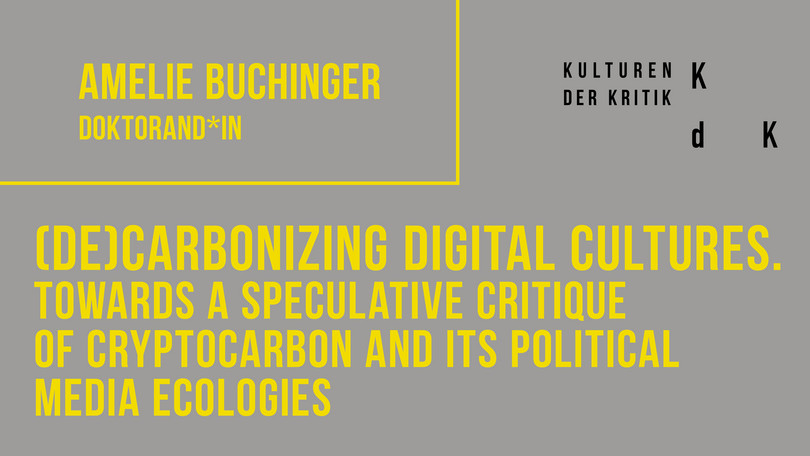
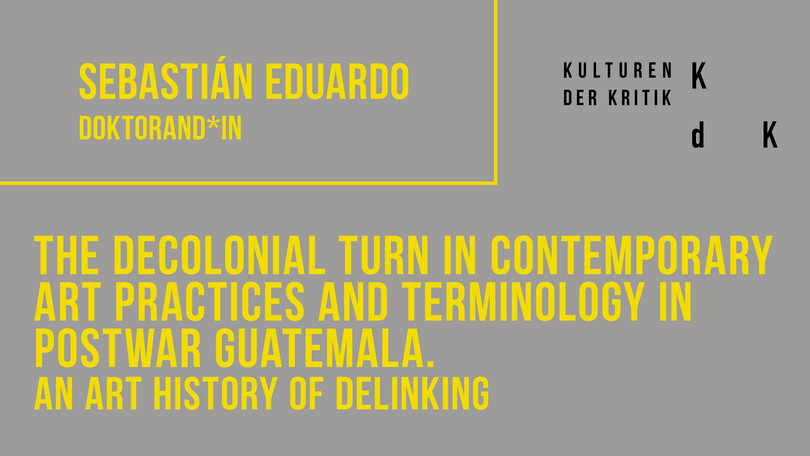
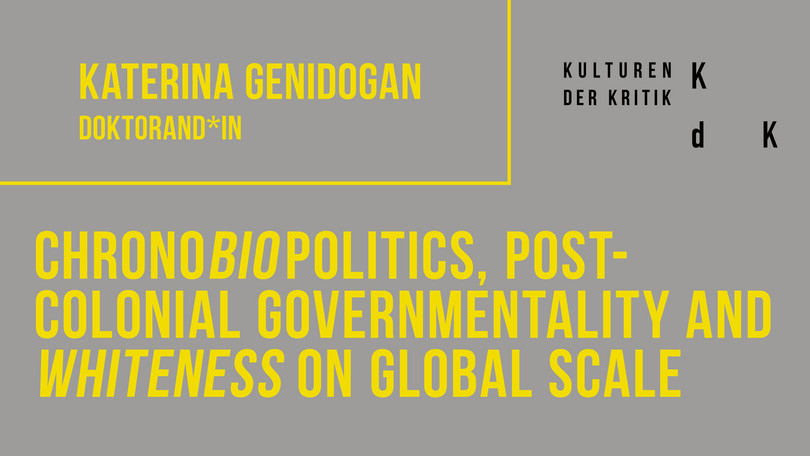
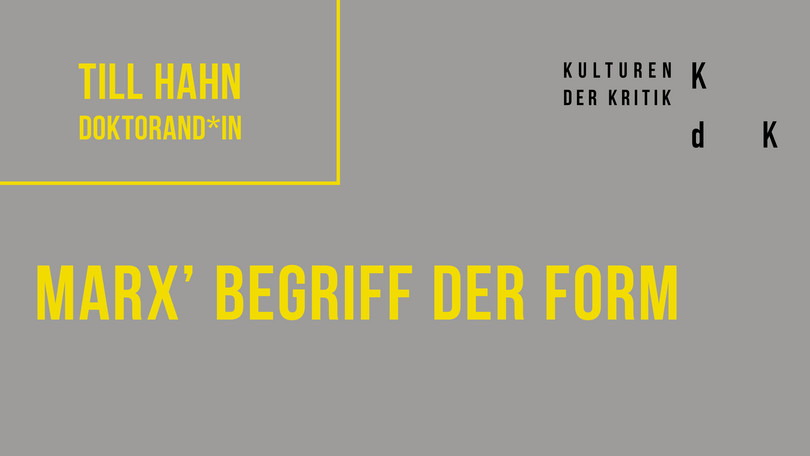
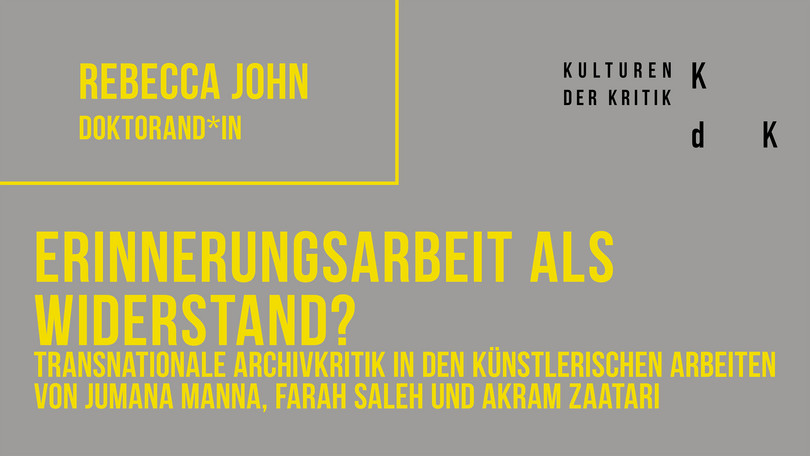
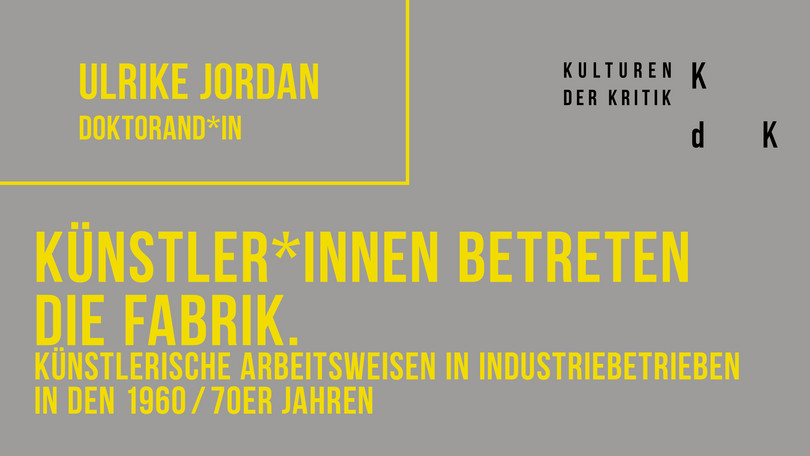
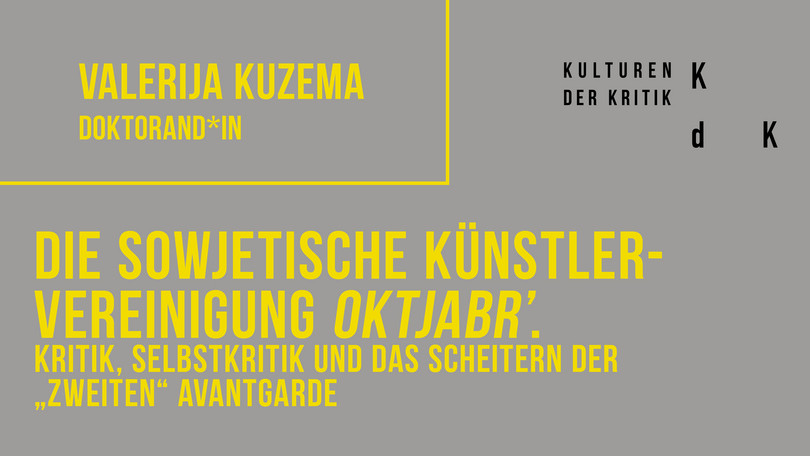
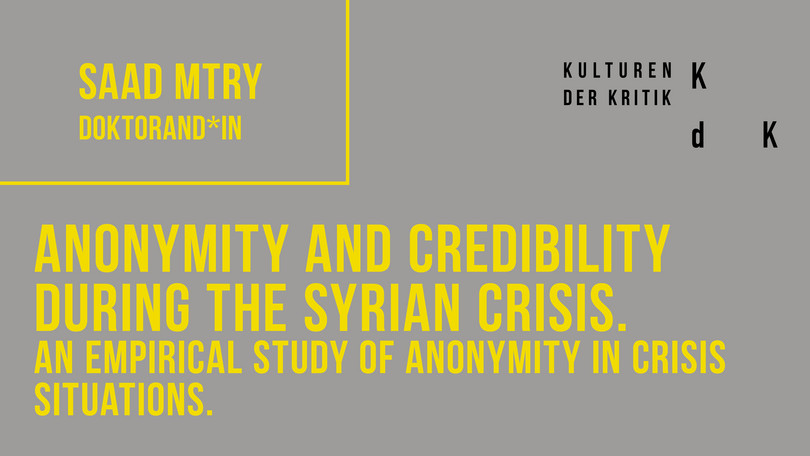
![[Translate to Englisch:] Poster Thumbnail Malte Fabian Rauch](/fileadmin/_processed_/2/9/csm_200526_Web_KdK-visuals_final25_f4be3e4576.jpg)
